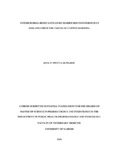| dc.description.abstract | Enterococci are common causes of nosocomial infections in humans with Enterococcus faecalis and Enterococcus faecium being the most predominant species responsible for these infections. The increased prevalence and dissemination of drug-resistant Enterococcus spp. worldwide has resulted in a major decrease in therapeutic options because the majority of Enterococcus spp. isolates from various regions of the world are now resistant to ampicillin and vancomycin which are traditionally the most useful anti-enterococcal antibiotics.
The objective of this study was to profile phenotypic antimicrobial resistance of enterococcal isolates from baboons to selected antimicrobial agents and also to investigate the genetic basis of such resistance. The study also undertook Basic Local Alignment Search Tool (BLAST) analysis of sequenced PCR amplicons of resistant determinants.
Investigations were done on 73 isolates obtained from the faecal samples of captive baboons (Papio Anubis) housed at the Institute of Primate Research (Nairobi, Kenya). Identification of Enterococcus spp. was by selective medium (Slanetz and Bartkey) and final confirmation was done by Polymerase Chain Reaction (PCR) using primers specific to the 16S rRNA gene of Enterococcus spp. Antimicrobial susceptibility testing (AMST) was performed by Kirby-Bauer disc diffusion method according to Clinical and Laboratory Standards Institute (CLSI) guidelines. A total of six commonly used antimicrobial agents were tested. The antimicrobial agents were ampicillin (10μg), vancomycin (30μg), doxycycline (30μg), erythromycin (15μg), levofloxacin (5μg), and linezolid (30μg). CLSI zone diameter interpretive break points for these antimicrobial agents were: Ampicillin (≤16 ≥17), vancomycin (≤14 ≥17), doxycycline (≤12 ≥16), erythromycin (≤13 ≥23), levofloxacin (≤13 ≥17) and linezolid (≤20 ≥23). For each isolate, susceptibility testing was done three times and the mean zone diameter of inhibition was calculated. The mean diameter was then compared to the interpretive standard break points for Enterococcus spp. for each tested antibiotic. Staphylococcus aureus
xiii
ATCC 25923 was used as the reference organism. DNA of the phenotypically resistant Enterococcus spp. isolates were extracted and thereafter specific PCR assays were used to detect resistance determinants in resistant isolates. The PCR amplicons were electrophoresed on 1.3 % agarose gel in Tris-acetate-EDTA buffer supplemented with 0.5μg/ml of ethidium bromide and calibrated using 100 bp DNA ladder. The gels were visually inspected by UV-transilluminator. The amplicons obtained were purified and thereafter sequencing was done using the ABI PRISM 3770 genetic analyzer. A BLAST analysis was done to confirm the identities of the sequenced amplicons and their location on chromosomal DNA or extra-chromosomal genetic mobile elements. Cluster analysis of the resistance genes was done and a distance tree generated. BLAST analysis was also used to determine the geographical distribution and diversity of hosts from which genes’ homologues had previously been isolated. The sequenced resistance genes were submitted to the National Center for Biotechnology Information genetic sequence database (NCBI GenBank) for validation and assignment of accession numbers.
Overall, 26 isolates out of 73 (35.6 %) showed phenotypic resistance to erythromycin, which is a macrolide. Resistance to doxycycline, a tetracycline, was found in two isolates (2.7 %). None of the enterococcal isolates showed any phenotypic resistance to either ampicillin, levofloxacin, vancomycin or linezolid. Erm(B) genes were detected in 5 out of the 26 (19 %) erythromycin resistant phenotypes following PCR assay. The erm(B) genes detected in this study were 639 bp and 548 bp gene fragment amplicons using two different sets of primers. None of the isolates tested positive for the resistance determinant erm(A). The resistance determinant tet(L) was detected in the two doxycycline resistant phenotypes whereas the resistance determinant tet(M) was found in only one of the isolates. The tet(L) gene was detected as a 229 bp gene fragment amplicon while Tet(M) was detected as a 406 bp gene fragment amplicon. None of the isolates tested positive for the resistance determinant tet(O).
xiv
However, one isolate tested positive for the resistance determinants erm(B), tet(L) and tet(M). BLAST analysis of the sequenced PCR products revealed that all the resistance genes had 100 % nucleotide identity to sequences in the NCBI GenBank database, except the tet(L) genes, which had a 99 % identity. Analysis of the resistant determinants revealed that all the resistant enterococci were E. faecium strains. The sequenced enterococcal resistance determinants submitted to the NCBI GenBank that were longer than 200 bp were assigned accession numbers as follows: E90A (KR494221), E54 (KR494222), E62 (KR494223), E90B (KR494224), E79 (KR494225), E76 (KR494226) and E79 (KR494227).
This study shows that baboons harbour erm(B) and tet(L) Enterococcus faecium resistance determinants. The study further shows a possible association of these resistance determinants with mobile genetic elements plasmids and transposons and therefore they have the potential to be transferred to human handlers and researchers. This study also showed that all enterococcal isolates had no phenotypic resistance to vancomycin and linezolid which are the last line antimicrobial agents in the region. | en_US |



